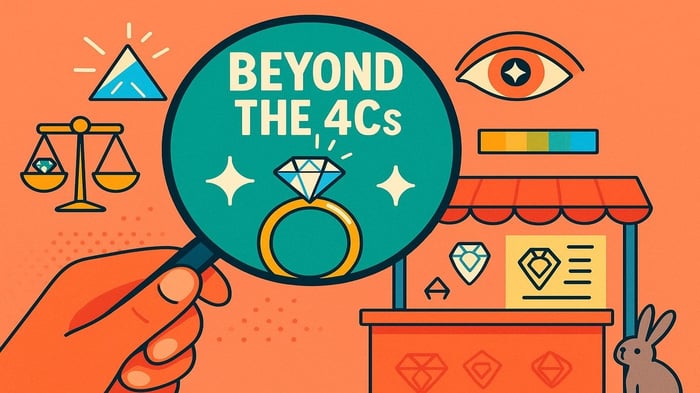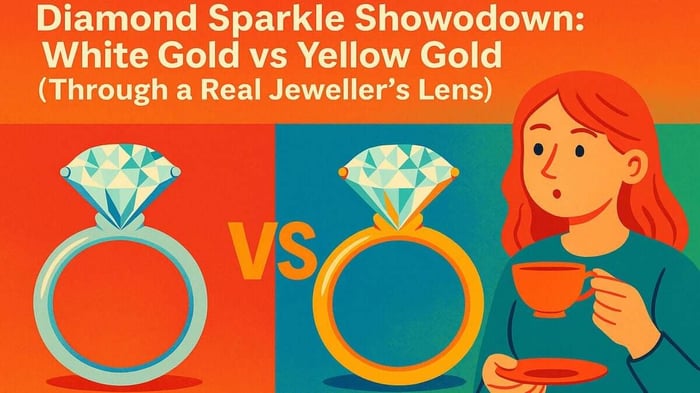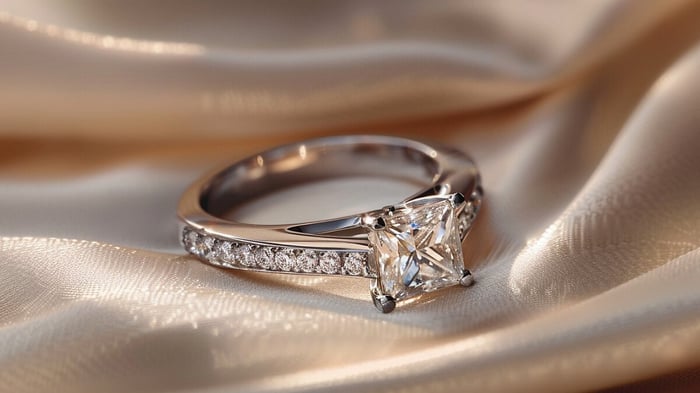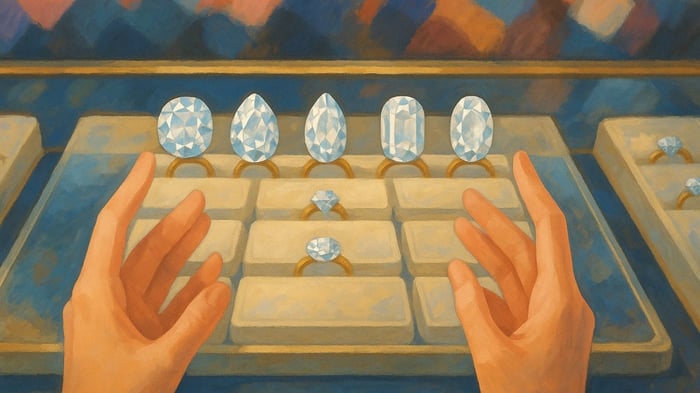In This Article
Let me spill a secret: the first time I shopped for an engagement ring, I thought I knew what 'carat' meant (spoiler: I was wrong—they're not just for rabbits). Whether you're planning a big proposal or just window shopping, lab diamond rings have changed the game. But the rules? They're not the same as your grandma’s. Here's your anti-confusion guide to choosing a lab diamond, with tips I wish I'd had, from weird colour codes to why 'flawless' isn’t always as perfect as it sounds.
TL;DR: The four Cs (cut, clarity, colour, carat) still matter, but lab diamonds let you set higher standards without breaking the bank. F colour or better, VS clarity or higher, and an excellent cut are your best friends. Always double-check the carat size (not just weight), and instead of chasing 'flawless', look for brilliance. Happy hunting!
Four Cs, No Nonsense: What Actually Matters for Lab Diamonds?
So, you’re deep in the hunt for the perfect Lab Grown Diamond Engagement Ring, and everywhere you turn, it’s all about the Four C’s of Diamonds: Cut, Color, Clarity, Carat. But here’s the twist—lab-grown diamonds flip the script, and you need a Diamond Buying Guide that actually makes sense for today’s market.
First, let’s clear the air: Lab Grown Diamonds are physically, chemically, and visually identical to mined diamonds. The only real difference? They’re made in a lab, not dug from the earth. That means you get all the sparkle, minus the guilt—and, as research shows, usually at 15%-30% less cost. (Yes, that’s real. I celebrated with extra dessert too.)
But don’t get lost in the old-school hype. The Four Cs still matter, but the order of importance shifts a bit for lab diamonds:
- Cut – This is your non-negotiable. The cut determines how brilliantly your diamond sparkles. Always go for “Excellent” in cut, polish, and symmetry. If you’re after that jaw-dropping shine, nothing else will do.
- Colour – “The less colour a diamond had, the more valuable it was. And what do we mean by colour? And it's a very specific colour. It's yellow.” For lab diamonds, you’ll find it’s much easier (and cheaper) to get higher colour grades. Most buyers should aim for F colour or higher—upgrading from H to E colour costs hundreds, not thousands, as it does with naturals.
- Clarity – Lab diamonds are grown in controlled environments, so inclusions are less of a worry. You can often get a cleaner stone for less.
- Carat – Remember, carat is weight, not size. A well-cut 2-carat lab diamond should look like a true 2-carat, not a shrunken version.
Here’s a quick look at how Lab Diamond Pricing compares to natural diamonds:
| Feature | Lab Grown Diamonds | Natural Diamonds |
|---|---|---|
| Price Difference | 15%-30% less expensive | Standard pricing |
| Color Upgrade (H to E) | Hundreds | Thousands |
| Recommended Minimum Color | F or higher | F or higher |
One last thing: don’t fall for the “natural diamond is better” myth. The standards have shifted. Lab-grown lets you access higher grades for less, and that’s a game-changer.
Four Stone Lab Diamond Eternity Ring 4.00ct D/VVS in 18k Yellow Gold
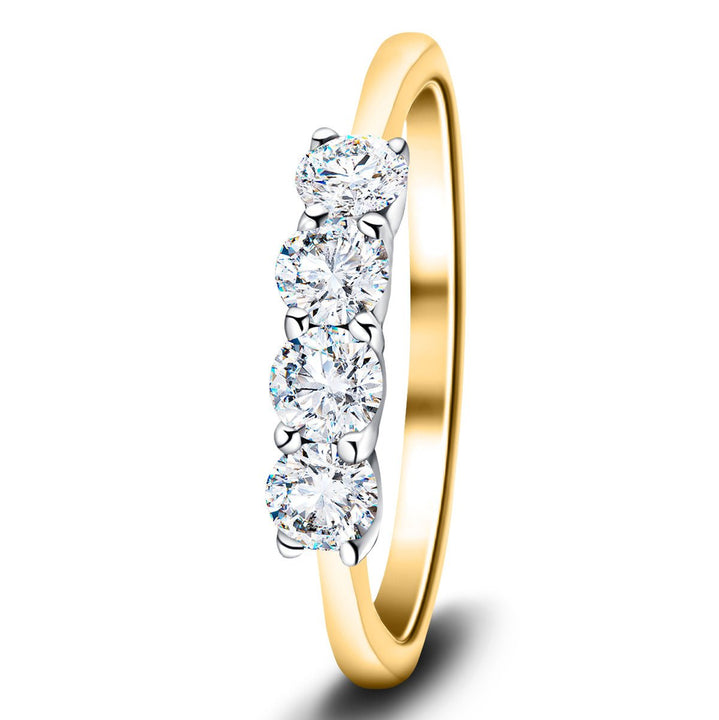
£4,111.00
£7,901.00
Discover a treasure that will shine forever with the Four Stone Lab Diamond Eternity Ring. This stunning ring is designed in the UK. It features IGI-certified D/VVS lab-grown diamonds that sparkle with a combined weight of 4.00 carats. The diamonds… read more
The Shiny Details: Prioritizing Cut, Colour, and Clarity (and Dodging 'Perfection' Traps)
Let’s get real: when you’re shopping for a lab diamond engagement ring, it’s easy to fall down the rabbit hole of technical jargon and microscopic differences. But here’s the secret—lab diamond quality comes down to three main things: cut, colour, and clarity. Nail these, and you’ll have a ring that dazzles without draining your sanity (or your wallet).
Colour: F and Up—Your Sweet Spot for a Natural White Look
Diamond colour grading runs from D (purest, icy white) to Z (noticeably yellow). With lab-grown diamonds, you don’t have to pay a fortune for that crisp, colourless sparkle. Research shows that F colour is the “minimum” you should aim for—anything lower, and you might start to see a hint of yellow. The best part? The price jump between, say, E and F on lab diamonds is usually just a few hundred dollars, not thousands like with natural stones. So, you get that high-quality lab diamond look without the sticker shock.
Clarity: VS or VVS—No Loupe Needed
Clarity is all about what’s trapped inside the diamond—those little imperfections called inclusions. Here’s the thing: “Versus clarity will ensure you can’t see any inclusions with the human eye.” For lab diamonds, VS (Very Slightly Included) or VVS (Very, Very Slightly Included) is the gold standard. Why? Because lab diamond pricing lets you afford this level of perfection, so there’s no reason to settle for less. SI (Slightly Included) might look fine on paper, but sometimes the diamond just doesn’t look right. Stick with VS or better, and your diamond will look flawless to everyone—except maybe a jeweller with a microscope.
Cut is King: Go Excellent or Go Home
Lab diamond cut quality is what gives your stone that jaw-dropping sparkle. “Our tip is go excellent every time. That is a non-negotiable.” Look for “Excellent” grades in cut, polish, and symmetry. This combo maximises light performance, making your diamond pop from across the room. For round diamonds, you’ll see all three grades on the certificate. For fancy shapes, focus on polish and symmetry.
Don’t Chase ‘Flawless’—It’s Overrated
Here’s a little-known fact: flawless is a technical term, and the status can vanish with a single fingerprint or scratch. Instead of stressing over perfection, focus on beauty and brilliance. High-quality lab diamonds are about what you see, not what’s on a grading report.
Layla Lab Diamond Halo Princess Engagement Ring 3.75ct D/VVS in 18k Yellow Gold
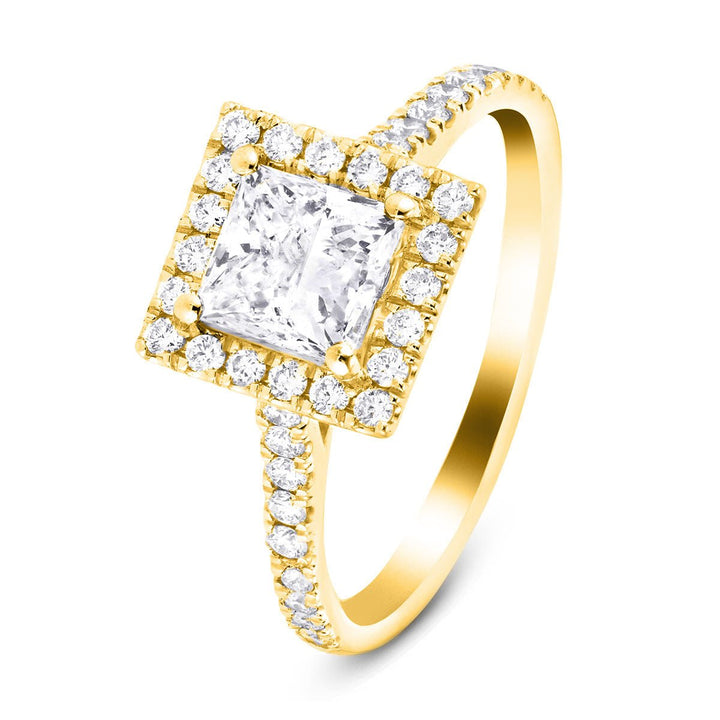
£2,592.00
£10,331.00
Make a statement of elegance and luxury with this Layla Lab Diamond Halo Princess Engagement Ring, designed to take your breath away. Expertly crafted in the UK, this ring features 3.75 carats of breathtaking, diamonds. The dazzling diamonds are set… read more
Carat: When Size Isn’t (Exactly) Everything – Don’t Get Tricked by the Numbers
Let’s be honest—when you first start your engagement ring guide journey, “carat” is probably the first word you hear. It sounds simple. Bigger carat, bigger diamond, right? Well, not so fast. Here’s where things get a little sneaky, especially with lab-grown diamonds. One important distinction:
Carat is a measurement of weight, not size.That means two diamonds with the same carat weight can look totally different on your finger.
Here’s why: the way a diamond is cut changes how big it actually looks. Imagine two 2-carat round diamonds. One is cut shallow, so it spreads out wider across the top. The other is cut deep, so more of its weight is hidden below the setting. Both weigh the same, but the shallow one looks bigger. The deep one? It might look more like a 1.8-carat stone, even though you paid for two.
So, how do you avoid getting tricked by the numbers? Always check the millimeter (mm) diameter—not just the carat weight. For a standard round lab diamond, a true 2-carat should measure about 8 mm in diameter. If you spot a “2-carat” diamond that’s only 7.7 mm across, it’s probably cut too deep. That’s why some deals seem too good to be true: you’re getting the weight, but not the face-up size. And when it comes to ring aesthetics, visual size is everything.
- Carat Weight vs Size: Don’t just chase numbers. A well-cut diamond will look its carat weight—or even bigger!
- Lab Diamond Budgeting: If you’re comparing prices and one diamond is way cheaper, check the mm measurements. A smaller face means a lower price, even if the carat weight matches.
- Engagement Ring Guide Tip: For round diamonds, 2 carats = 8 mm. For other shapes (oval, princess, etc.), always ask for the mm size. Don’t just trust the carat label.
Research shows that balancing carat, cut, and face-up size is key for a stunning ring. “You want to focus on the carat weight but also to make sure the millimetre diameter is right for that standard.” If you want your lab diamond to truly shine, don’t let carat weight fool you—let the numbers work for you, not against you.
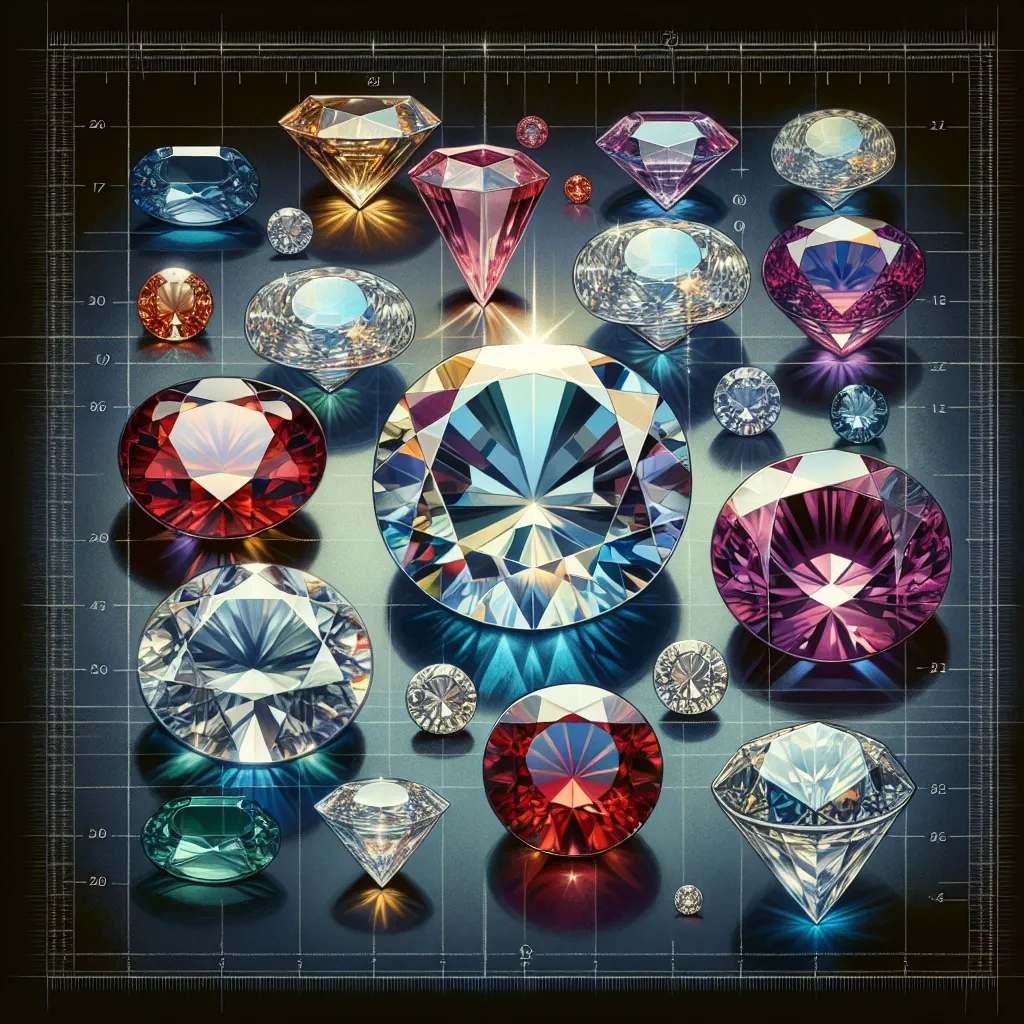
Crafting Your Perfect Lab Diamond Story (and Avoiding Common Missteps)
Let’s be honest—choosing a lab diamond engagement ring can feel like you’re prepping for a final exam you never signed up for. There’s the Four Cs (cut, colour, clarity, carat), endless charts, and a dizzying array of choices. But here’s the secret: while the Four Cs matter, what truly lasts is the sparkle that catches your eye, the colour that feels “just right,” and the size that makes your heart skip a beat.
Research shows that sparkle, personal taste, and visual appeal always trump technical perfection when it comes to lab-grown diamonds. Yes, the cut is crucial—after all, it’s what gives your diamond that unforgettable brilliance. Colour and clarity? Important, but don’t let a tiny difference on a grading report overshadow what you actually see and love. And carat? Sure, size matters, but only if it looks and feels right to you.
Here’s something else to remember: lab-created diamonds are not only more sustainable, but they’re also generally 15% to 30% less expensive than mined stones. That means you can focus on beauty and craftsmanship—maybe even go a little bigger or higher quality—without blowing your budget. It’s not about chasing the highest grades; it’s about finding a diamond that feels like yours.
Navigating all these choices can be confusing, especially if you’ve never done it before. And that’s okay. This process isn’t just a technical selection—it’s a personal journey. Your diamond engagement ring is a symbol, not a science test. Don’t let yourself get lost in the data or let spreadsheets dictate what should be a joyful, meaningful decision.
All of the above will not matter if you pick something which is just good because you ultimately you want a diamond to sparkle.So, imagine this: years from now, you’re telling your grandkids the story of your ring. Would you rather say you picked it because it sparkled brightest under the shop’s fluorescent lights, or because a spreadsheet told you it was “the best”? The answer is clear. Let your heart—and your eyes—lead the way. With lab-grown diamonds, you have the freedom to choose beauty, value, and a story that’s truly your own.
Choose Your Lab Diamond Engagement Ring
Nancy Lab Diamond Halo Pear Engagement Ring 3.75ct G/VS in Platinum

£3,670.00
£7,001.00
Indulge in pure luxury with the stunning Nancy Lab Diamond Halo Pear Engagement Ring, meticulously crafted by hand in the UK. This ring features a captivating 3.75-carat total weight of G/VS-graded diamonds, including a magnificent pear-shaped diamond at the centre… read more


